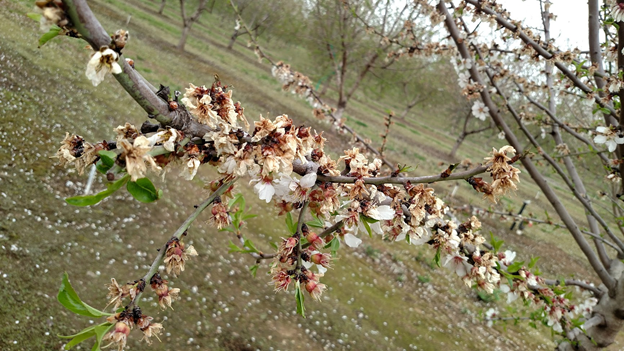Luke Milliron, UCCE Orchard Advisor, Butte, Tehama & Glenn Counties
Phoebe Gordon, UCCE Orchard Advisor, Madera and Merced Counties
Bacterial blast (Pseudomonas syringe), although thankfully not a problem every year (hopefully including 2022), can be tremendously damaging to almond yields. For example, significant crop damage was reported in the Sacramento Valley in 2017 and 2018, and in the San Joaquin Valley in 2017 and 2019. These grower reports of past crop loss supported a Section 18 emergency request for the use of kasugamycin on almonds during bloom. In 2020 and 2021, there were excellent bloom conditions and bacterial blast was not a problem. As of this writing on February 3, 2022, bacterial blast risk looks very low with excellent almond bloom weather in the current forecast. However, keep an eye on the forecast, as things can quickly change.
DPR and EPA approved this emergency request for kasugamycin (Kasumin 2L) use during the 2022 bloom season ONLY for February 1 through April 15. The request was granted for select counties that had supplied crop loss data, these counties included Yolo, Sutter, Yuba, Colusa, Glenn, Butte, and Tehama in the Sacramento Valley as well as San Joaquin, Stanislaus, Merced, Madera, and Fresno in the San Joaquin Valley. This emergency approval allows for use of kasugamycin for bacterial blast when cold or freezing conditions are expected at a use rate of 64 fluid ounces in at least 100 gallons of water per acre by ground application. If you are interested in using kasugamycin during bloom, please contact your local Agricultural Commissioner’s office, talk with your PCA, and carefully follow the label, label is law.
In past years, some almond growers have reported 20-40% crop losses, in part due to blast. For example, bacterial blast hit some varieties in the Regional Almond Variety Trials in Butte and Madera Counties in 2017 and 2019. The bacteria P. syringae which can cause both blast (in blossoms) and canker (in bark) is ubiquitous on surfaces in our orchards, however it only causes infections under the right conditions. The right conditions for bacterial blast and canker are wet and cold (e.g. frost). These conditions stress the tree and make them more vulnerable to infection, as is the case for bacterial canker, which is a different expression of the same infection. For example, in 2017, the Regional Almond Variety Trial at CSUC experienced four nights below 30ᵒF coinciding with full bloom and significant damage was observed (photo 1). Copper has been the only main control measure for this disease, however copper resistance in P. syringae is widespread and copper sprays are believed to be mostly ineffective at controlling this pathogen.
In a 2021 episode on Growing the Valley podcast, Dr. Jim Adaskaveg (UC Riverside) gives an update on bacterial blast management, including the efficacy of kasugamycin.
Mention of a pesticide does not constitute a pesticide recommendation. Special thanks to Dr. Jim Adaskaveg who wrote the Section 18 request, to Aubrey Bettencourt and the Almond Alliance who submitted the request to DPR, and to the Central Valley almond growers who supplied crop loss data.



Leave a Reply